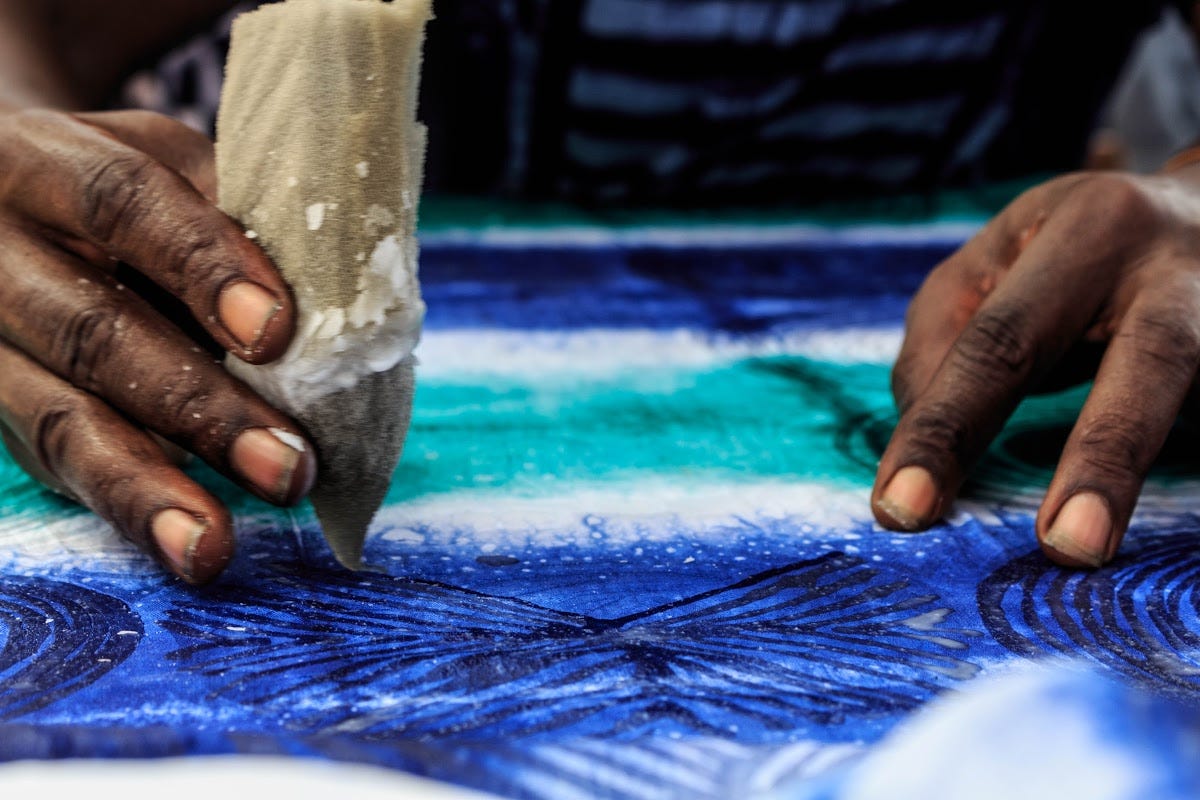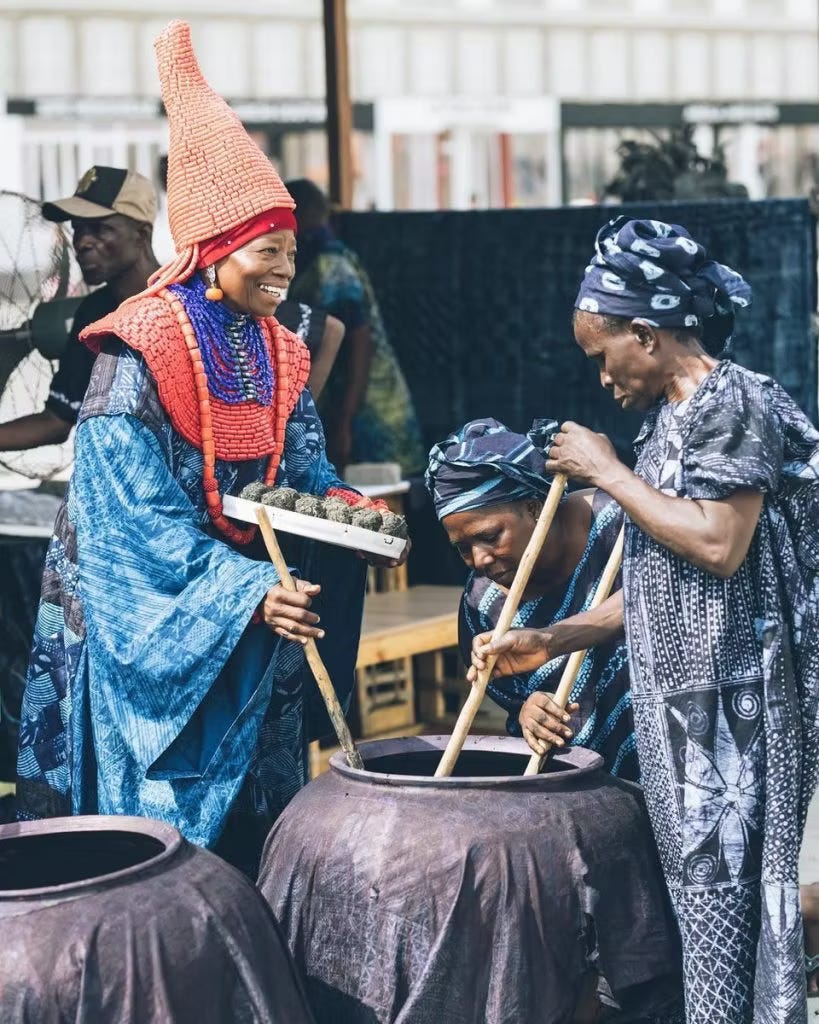What defines luxury?
Is it time? Rarity? Beauty? Heritage? Meaning?
Or is it something more constructed? Like the French Maisons that tell the story, the material standards they maintain, the symbolism they refine over decades?
These are the questions that surface when I think about Adire, the Yoruba resist-dyed textile tradition. A tradition deeply spiritual, historically feminine, and profoundly created in generational craft.
It has long been described as “cultural,” “traditional,” “artisanal.” But what if we looked again but through a different lens?
Could Adire be considered a form of luxury? And if not yet, why not?
Rethinking What Luxury Means
Today, the global definition of luxury is shifting.
Luxury is no longer just about logos or price tags. It is about depth, the story, the hand, the time, the trace of humanity.
According to Bain & Company, 73% of luxury consumers now prioritize craftsmanship, sustainability, and meaning over heritage brands alone.
McKinsey has identified authenticity, cultural relevance, and storytelling as key to future growth in the luxury market.
If that is true, then Adire fits beautifully - on principle.
Where Adire Aligns With Luxury
Adire is not fast fashion. It cannot be rushed. Depending on the technique, a single cloth may take anywhere from three days to two weeks to complete, from hand-tied stitching to starch-resist painting to multiple rounds of indigo dyeing.
Each piece is singular and the artisan’s fingerprint is always present, always unrepeatable.
And unlike surface decoration, Adire motifs carry spiritual language. One such motif seen in the 1930 - 1970 collection from the Eko Bank Adire fair, likely Alafia, uses geometry to invoke peace and order. Another, Irinkerindo, depicts the path and spiritual ascension of the traveller - a metaphor for life’s journey, restlessness, and growth.
These are not simply patterns. They are philosophies made wearable.
Adire is also sustainable, human-centered, and emotionally resonant. It carries memory. It carries place. By all these measures, it embodies the very soul of what luxury is trying to return to.
So Why Hasn’t It Been Treated as Luxury?
This is where the reflection must deepen. Because while Adire reflects the principles of luxury, it hasn’t yet developed the infrastructure of luxury.
Not because it lacks value but because it lacks structure.
Here’s what that means:
1. The Storytelling Ecosystem Is Fragile
Many Adire artisans come from unrecorded lineages. Generational mastery is being lost quietly. It’s not documented, not archived, not platformed.
Unlike luxury maisons, there are no widely known creative directors, ateliers, or brand stories that define identity over time.
2. There Are No “Adire Houses”… Yet
Hermès began as saddlers. Missoni began with wool. Their genius was not just in craft, but in building continuity, innovation, and brand identity around a single medium.
Adire currently lacks that. There is no singular house that has elevated the fabric into luxury design, curating collections, investing in elevated materials, or translating Adire into global product ecosystems.
3. The Material Base Needs Refinement
Many Adire cloths today are made on inexpensive cotton with basic finishing. Not out of neglect, but due to local supply chains and market constraints.
Yet global luxury standards demand tactility, longevity, finish. Until Adire is consistently made on high-quality base cloths or woven to match its artistry, its tactile perception may fall short of expectation.
4. The Design Language Has Not Fully Evolved
Luxury is not just craft, it is also form, silhouette, and interpretation.
While Adire carries deep meaning, it is often used in raw formats or overly commercial styles. There is still a gap between tradition and contemporary design thinking that keeps it from entering global concept stores or runway spaces.
A More Honest Conclusion
So, is Adire a form of luxury?
In principle, absolutely. In perception, not yet.
It is not because Adire lacks value.
It is because we have not yet built the institutions, brands, and design refinement needed to frame it as such for ourselves, or for the world.
What Must Happen Next
If Adire is to take its place in the global luxury conversation, it must be:
Documented: The histories, artisans, motifs, and methods must be archived with care.
Designed: A new generation of creatives must translate Adire into form - think garments, interiors, collectible objects made with elegance.
Housed: A brand, a maison, a movement must carry the tradition forward with consistency and vision.
Respected: Locally, we must begin to treat Adire as precious not casual, not nostalgic, but a living cultural asset.
A Final Reflection
What makes something luxury is not the culture it comes from.
It is the care, attention, and belief that surround it.
Adire has everything luxury asks for - time, story, soul, skill. What it needs now is elevation.
Not rebranding. Not dilution. But investment, vision, and continuity.
Because perhaps the question is not whether Adire is luxury… but whether we are ready to build the world where it can be seen that way.




